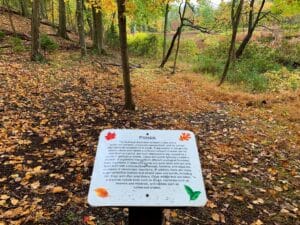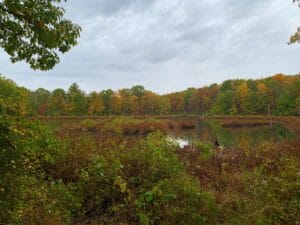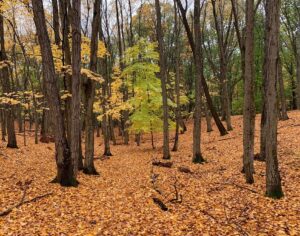Hello, fellow readers, It never occurred to me that there is an inconsistency of what defines a pond versus a lake; if I may share a walk in the woods, that leads to the curious question.
After our weekly volunteer sing at the Karen Ann Quinlan Home for Hospice on Friday, I enjoyed a walk in the rain at Lodestar Park in Fredon, NJ. There’s something serene about walking amongst raindrops. Especially when a drizzle hits your face, feeling like kisses from heaven.
Beyond the hayfield trail, I made a right onto the Nature Trail, which meanders through the woods. The golden carpet of fallen leaves covering the path was soft to walk on. I stopped to listen to the raindrops’ cadence, taking in the miracles of the cycle of life—the rhythm of nature, the change in seasons.
The distinction between a lake and a pond is not standardized.
There’s a small pond where an informational plaque stands. It explains that “the technical distinction between a lake and a pond has not been universally standardized,” which piqued my interest. Aren’t ponds shallow and small compared to deeper and larger lakes? But I suppose everything is up to interpretation, and research proved so.
 I came upon the term Limnology – “the study of the biological, chemical, and physical features of lakes and other bodies of freshwater,” per Oxford’s dictionary. In the late 18th to early 19th centuries, limnologists defined a lake as deep enough to have two or three water layers in varying temperatures, called thermal stratification. Ponds, on the other hand, are shallow enough to have rooted plants along the bottom throughout.
I came upon the term Limnology – “the study of the biological, chemical, and physical features of lakes and other bodies of freshwater,” per Oxford’s dictionary. In the late 18th to early 19th centuries, limnologists defined a lake as deep enough to have two or three water layers in varying temperatures, called thermal stratification. Ponds, on the other hand, are shallow enough to have rooted plants along the bottom throughout.
But today’s limnologists understand that nature has no exacting categories. There are deep lakes and ponds, shallow lakes and ponds, and other differences.
 How ponds and lakes are formed.
How ponds and lakes are formed.
The park plaque explains, “A depression which collects and retains a sufficient amount of water can be described as a pond, and a variety of geological events causes such depressions.” We all learned about the ice age and the impact of glaciers in school.
Ponds and lakes can be human-made or made by critters, such as beavers here and alligators elsewhere. During summer droughts, fires can cause a divot that fills with water after the dry spell ends. Temporary ponds after snowmelt or rainy seasons are called Vernal Ponds, vital spots for amphibians to breed.
Sometimes, names are changed from pond to lake when real estate is involved. A “Lake Front Home” seems to fetch a more significant price tag. However, ponds add beauty to a landscape and benefit our wildlife.
What are Pond-less waterfalls?
A long-time client in Denville, NJ, wants to add a water feature. Stephanie is all about allowing critters to have their share. Much to my chagrin, she’ll look the other way when deer nibble rather than use deer spray when needed, especially during their fall feeding frenzy. “It’s Nature’s way of pruning,” Stephanie says.
A traditional pond is not feasible because of the elevations and the proximately of a beloved oak tree. Instead, we’re planning a pond-less waterfall. A water reservoir and pump buried into the garden will rotate the water down a stream we’ll build with indigenous boulders and pockets for native plants.
Pond-less waterfalls will not sustain fish, aquatic insects, and water plants, as described in the park’s plaque. But Stephanie gleefully considers how “the birds will adore it, and the deer will have a place to drink.” Plus, it will be a draw to important pollinators like dragonflies and butterflies. Beyond that, she’ll enjoy a babbling stream’s serenity and soothing sounds. I like to think the wildlife will, too.
Garden Dilemmas? AskMaryStone@gmail.com (and now on your favorite Podcast App.)
Link to a previous column about the Safe Havens of Vernal Ponds
There’s more to the story in the Garden Dilemmas Podcast:
More about pond-less waterfalls – DIY a Backyard Waterfall



